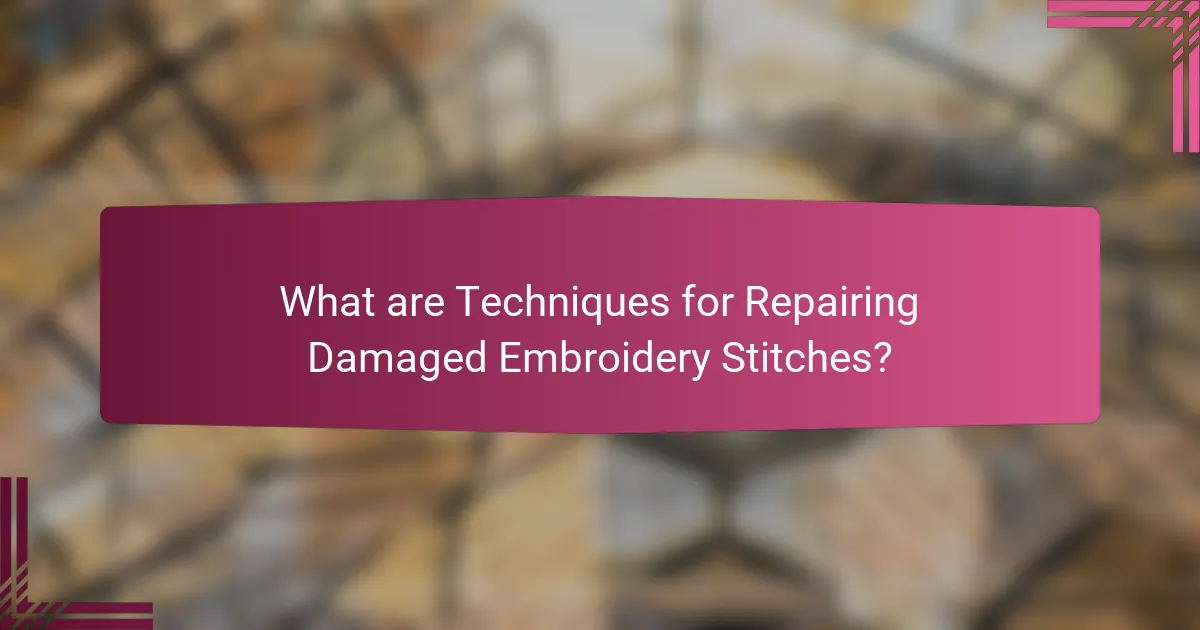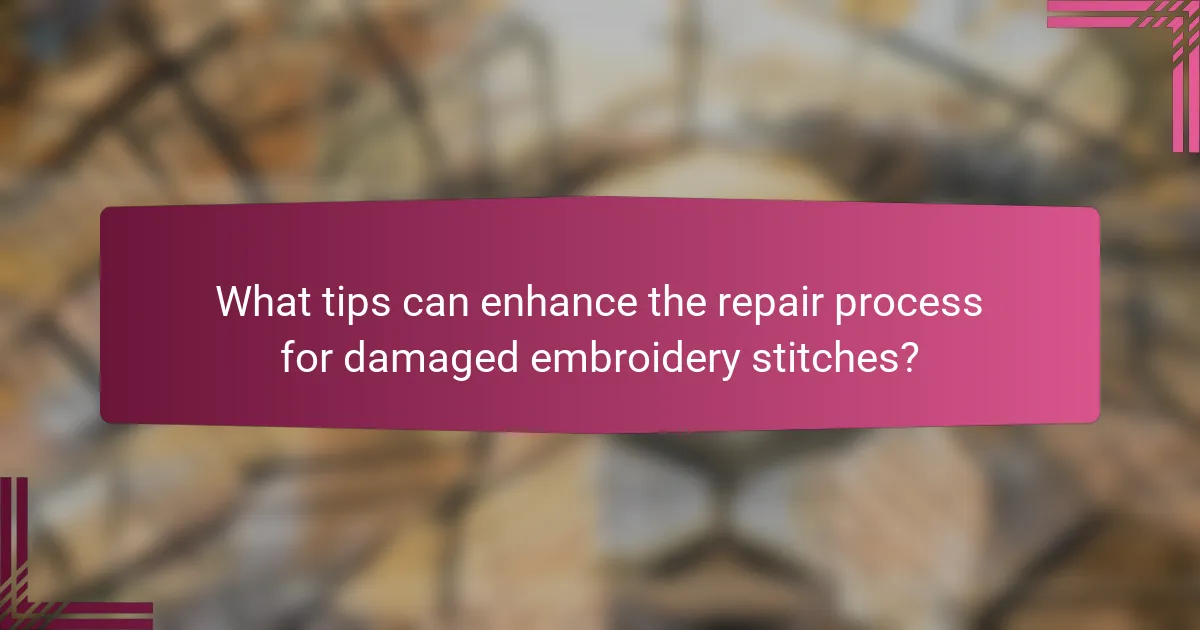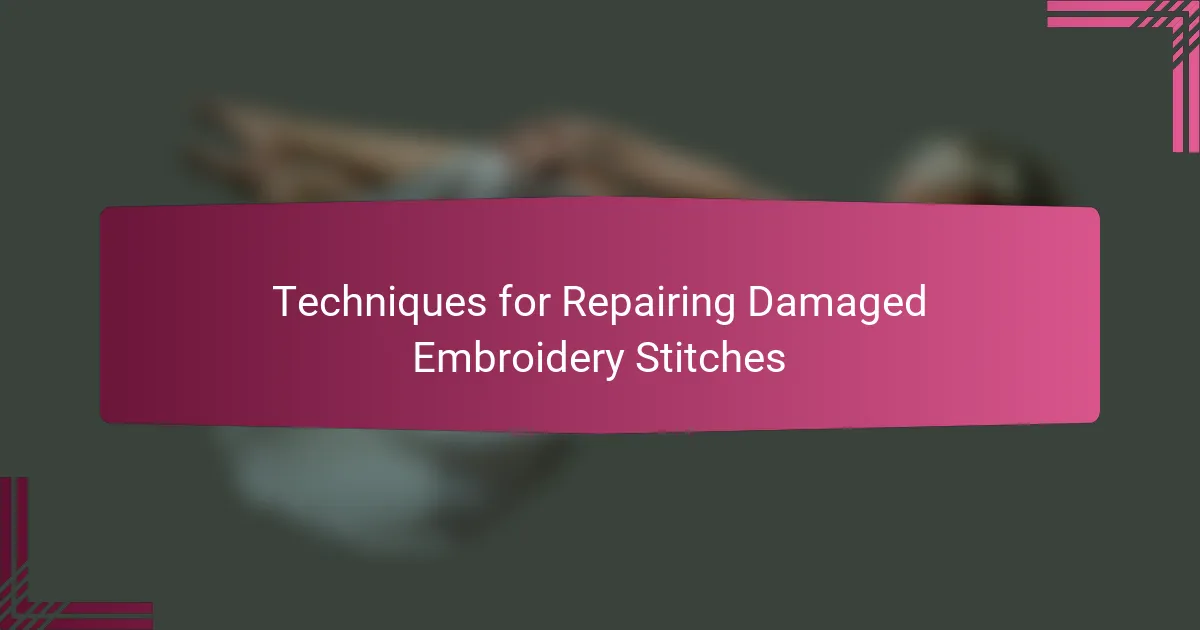
What are Techniques for Repairing Damaged Embroidery Stitches?
Techniques for repairing damaged embroidery stitches include re-stitching, patching, and using fabric glue. Re-stitching involves carefully removing the damaged stitches and replacing them with new ones. This method ensures continuity in the design. Patching is suitable for larger areas of damage. It involves sewing a piece of matching fabric over the damaged section. Using fabric glue can provide a quick fix for minor issues. It adheres the threads in place without the need for extensive sewing. Each technique can restore the integrity of the embroidery.
How can damaged embroidery stitches be identified?
Damaged embroidery stitches can be identified by examining their appearance and structure. Look for frayed edges or loose threads. Check for irregular spacing between stitches. Observe any color fading or discoloration. Notice if the stitches have come undone or are missing entirely. Assess the overall tension; uneven tension indicates potential damage. Inspect the fabric for holes or tears near the stitches. These signs indicate that the embroidery may require repair.
What signs indicate that embroidery stitches are damaged?
Damaged embroidery stitches exhibit several signs. Common indicators include fraying threads, which appear as loose or unraveled fibers. Gaps in the stitching can also be a clear sign of damage. Additionally, uneven tension may cause some stitches to be tighter than others. Discoloration of threads indicates wear or fading. Lastly, broken threads can lead to incomplete designs or sections. These signs collectively suggest that the embroidery requires repair to restore its integrity.
Why is it important to assess the extent of damage?
Assessing the extent of damage is crucial for effective repair. It helps determine the specific areas needing attention. Understanding the damage guides the selection of appropriate repair techniques. For instance, minor fraying may require simple stitching, while larger tears need more complex methods. Accurate assessment also prevents further deterioration during repair. It ensures that the final result maintains the integrity of the original embroidery. In embroidery, this process can significantly impact the longevity and appearance of the piece. Therefore, thorough assessment is fundamental to successful restoration.
What common techniques are used for repairing damaged embroidery stitches?
Common techniques for repairing damaged embroidery stitches include re-stitching, patching, and using a needle and thread for reinforcement. Re-stitching involves carefully replicating the original stitch pattern to restore the design. Patching is applied when a section is too damaged, using a piece of fabric to cover the area. Reinforcement can involve adding stitches around the damaged area to secure it. Each technique is effective depending on the extent of the damage. Proper tools, such as embroidery needles and matching thread, enhance the repair quality.
How does re-stitching work in embroidery repair?
Re-stitching in embroidery repair involves adding new stitches to replace or reinforce damaged areas. This technique helps restore the original design and integrity of the embroidery. First, the damaged area is assessed to determine the extent of the repair needed. Next, matching thread is selected to ensure color consistency with the existing embroidery. The embroiderer then carefully stitches over the damaged section, following the original pattern. Precision is crucial to maintain the aesthetic appeal of the piece. Re-stitching can effectively conceal flaws and prolong the lifespan of the embroidered item. This method is widely used in textile restoration and garment repair.
What role does patching play in fixing embroidery?
Patching plays a crucial role in fixing embroidery by providing a method to cover and reinforce damaged areas. It involves applying a piece of fabric over the affected embroidery to restore its appearance and functionality. This technique helps to prevent further fraying and extends the lifespan of the embroidered item. Patching can also enhance the aesthetic appeal by introducing new designs or colors. Additionally, it allows for the preservation of the original embroidery while effectively addressing the damage. Many embroidery repair experts recommend patching as a reliable solution for small tears or holes.
What tools and materials are necessary for repairing embroidery stitches?
The necessary tools and materials for repairing embroidery stitches include embroidery thread, needles, scissors, and a fabric patch. Embroidery thread is essential for matching the original stitch color. Needles must be suitable for the fabric type to avoid damage. Scissors are required for trimming any loose threads or fabric. A fabric patch can be used to cover larger areas of damage. These tools collectively enable effective repair of embroidery stitches and ensure a seamless finish.
Which types of needles are best for embroidery repair?
The best types of needles for embroidery repair are embroidery needles and ballpoint needles. Embroidery needles have a larger eye, allowing for thicker threads and preventing breakage. They also feature a slightly rounded tip, which helps to push aside the fabric threads without damaging them. Ballpoint needles are ideal for knit fabrics as they have a rounded tip that glides between fibers, reducing the risk of snagging. Both needle types ensure smooth stitching and effective repairs on various embroidery projects.
What threads are recommended for different fabric types?
Cotton threads are recommended for natural fabrics like cotton and linen. Polyester threads work well with synthetic fabrics, offering strength and durability. Silk threads are ideal for delicate fabrics such as silk and satin, providing a luxurious finish. For heavier fabrics like denim, use thick polyester or cotton threads for added strength. Rayon threads are suitable for lightweight fabrics, giving a smooth finish. Each thread type complements the fabric’s characteristics, ensuring optimal results in embroidery repair.

How can I effectively apply these techniques?
To effectively apply techniques for repairing damaged embroidery stitches, start by identifying the type of damage. Assess whether the stitches are frayed, pulled, or completely missing. Use a needle and thread that matches the original embroidery for seamless repairs. Carefully remove any loose threads to prevent further damage. Re-stitch the affected area using techniques such as backstitch or satin stitch, depending on the original pattern. Ensure that the tension of the new stitches matches the surrounding embroidery for consistency. Finally, secure the ends of the thread by knotting them and trimming any excess. This method ensures a clean and professional-looking repair.
What step-by-step process should be followed for re-stitching?
To re-stitch damaged embroidery, follow these steps. First, gather necessary tools like a needle, thread, and scissors. Next, assess the damaged area to determine the extent of the repair. Then, carefully remove any loose threads or damaged stitches using scissors. After that, thread the needle with matching embroidery thread. Begin re-stitching by inserting the needle from the back of the fabric to the front. Create small, even stitches following the original pattern. Continue stitching until the area is fully repaired. Finally, secure the thread by tying a knot at the back of the fabric and trim any excess thread.
How do I prepare the fabric before re-stitching?
Before re-stitching, prepare the fabric by cleaning and stabilizing it. First, remove any dirt or debris using a gentle brush or cloth. Next, assess the fabric for any fraying or damage. Cut away any loose threads to create a clean edge. If necessary, use a fabric stabilizer to reinforce the area. This helps maintain the fabric’s structure during stitching. Finally, press the fabric with an iron on the appropriate setting to eliminate wrinkles. This preparation ensures a smooth and successful re-stitching process.
What techniques ensure even and secure stitches during re-stitching?
Techniques that ensure even and secure stitches during re-stitching include maintaining consistent tension and using the correct needle size. Consistent tension prevents puckering and ensures uniformity in stitch appearance. Selecting the appropriate needle size for the fabric type helps to create secure stitches without damaging the material. Additionally, using a matching thread color enhances the visual consistency of the re-stitched area. Employing a straight stitch or a backstitch technique provides durability and strength to the repair. Finally, practicing on a scrap piece of fabric before re-stitching can help refine technique and ensure even results.
What are best practices for patching damaged embroidery?
To patch damaged embroidery, start by selecting a matching thread color. Use a needle suitable for the fabric type to ensure smooth stitching. Cut a patch that is slightly larger than the damaged area. Secure the patch in place with fabric glue or pins. Begin stitching around the edges of the patch using a straight or zigzag stitch. Ensure the stitches are tight and close together for durability. Trim any excess fabric after finishing the stitching. Iron the patch gently to flatten any raised edges and secure it further. These steps help restore the integrity and appearance of the embroidery effectively.
How should a patch be chosen and cut for effective repair?
To choose and cut a patch for effective repair, select a fabric that closely matches the original material. This ensures better integration with the existing embroidery. The patch should be slightly larger than the damaged area to cover it completely. Use sharp scissors to cut the patch for clean edges. A straight or zigzag stitch can be used to secure the patch. This prevents fraying and ensures durability. Additionally, consider the color and pattern of the patch to maintain aesthetic consistency. Matching these elements enhances the overall appearance of the repair.
What methods can be used to attach a patch securely?
Sewing and heat transfer are effective methods to attach a patch securely. Sewing involves using needle and thread to stitch the patch onto the fabric. This method provides strong durability and resistance to wear. Heat transfer uses an adhesive backing on the patch, which bonds to the fabric when heat is applied. This method is quick and easy, suitable for various materials. Both methods ensure that the patch remains in place during washing and daily use.

What tips can enhance the repair process for damaged embroidery stitches?
To enhance the repair process for damaged embroidery stitches, first assess the extent of the damage. Identify which stitches are frayed or missing. Use a needle and thread that matches the original embroidery for a seamless repair. Carefully remove any loose threads around the damaged area to prevent further unraveling. Recreate the missing stitches by following the original pattern closely. Maintain even tension while stitching to ensure consistency. Finally, secure the ends of the thread properly to prevent future damage. These steps facilitate a more effective and aesthetically pleasing repair.
How can I prevent further damage during the repair process?
To prevent further damage during the repair process of embroidery stitches, assess the area thoroughly. Identify the extent of the damage before starting repairs. Use a gentle approach when handling the fabric to avoid additional tears. Employ appropriate tools, such as a fine needle, to minimize fabric strain. Work in a well-lit environment for better visibility of the stitches. Secure the fabric in a hoop or frame to stabilize it during repairs. Avoid pulling too tightly on the threads to prevent distortion. Finally, consider using a stabilizer underneath the fabric for added support during stitching.
What maintenance tips can help preserve repaired embroidery stitches?
To preserve repaired embroidery stitches, handle the fabric gently during washing and drying. Use cold water and a mild detergent to prevent damage. Avoid wringing or twisting the fabric, as this can distort the stitches. Instead, lay the item flat to dry or use a low heat setting in the dryer. Iron the fabric on the reverse side using a low-temperature setting to protect the stitches. Store the item in a cool, dry place away from direct sunlight to prevent fading. Regularly check the stitches for any signs of wear or fraying, and address any issues promptly to maintain the integrity of the repairs.
Techniques for Repairing Damaged Embroidery Stitches encompass various methods, including re-stitching, patching, and fabric glue application. The article details how to identify damaged stitches through signs like fraying, gaps, and discoloration, emphasizing the importance of assessing damage for effective repair. It further outlines essential tools and materials, best practices for each repair technique, and maintenance tips to preserve the integrity of repaired stitches. By following these guidelines, individuals can effectively restore and extend the lifespan of embroidered items.
